► 2016’s most wanted cars: #1 is the Ford Focus RS
► 345bhp awd Focus RS takes the fight to Audi/Merc/BMW
► All for a price tag of under £30k – £10k cheaper than rivals
What’s $20,000 to you? To the Nitrous blue bundle of fury on these pages that’s the cost of tooling the brackets for a slightly thicker rear anti-roll bar, because nothing in the existing Ford parts bin was suitable. But more significantly, it’s the difference between ‘a bar that’s going to change the whole character of the car’ and a compromise. So says vehicle engineering manager Tyrone Johnson, explaining that it wasn’t a compromise he was prepared to make. ‘You don’t ask for $20,000 in mainstream engineering,’ he says with a laugh, ‘because that is a big deal.’ But for the new Focus RS? Nothing was impossible.
Almost everything about this third-generation Focus RS is extraordinary. Which is not the same as without limits. As the man in charge is quick to point out, there had to be a business case for everything he and his team chose to do; spending that $20k there meant $20k less to spend elsewhere. But seriously – name another car that has a four-wheel-drive system with a dedicated Drift Mode? Ford has built one into a five-door family hatch, given it 345bhp, stuck with a manual gearbox and then priced it at £28,940. If we’re currently in the midst of a mega-hatch war, this thing looks like a serious escalation.
Can it possibly be as good as the company claims? We’ve spoken to both Johnson and Focus RS chief programme engineer Jürgen Gagstatter, and cadged a passenger ride at Ford’s Lommel Proving Ground in Belgium to try to find out. This is the story of the hot hatch of 2016.
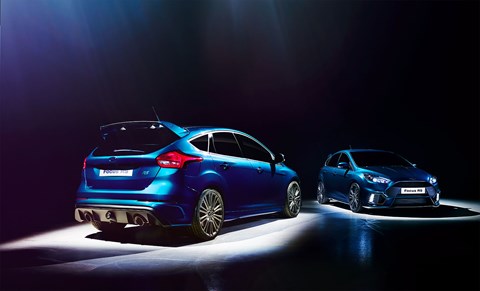
It’s been more than three years in the making, and has enjoyed support from right at the top since the start. ‘Raj Nair really wanted this car,’ Johnson says; Nair is Ford’s vice president and chief technical officer. ‘He really wanted this car. We probably wouldn’t be sitting here without him.’ This kind of cheerleading brings opportunities, but also challenges. There was no way Nair was going to let Johnson engineer the RS only for Europe, which would have been easier, and cheaper, than taking it into America as well. Instead, they had to figure out a way to make it work with both US and European safety regulations, and then come down a single production line in Saarlouis, Germany, amongst every other European Focus. ‘This was very, very difficult,’ he says. ‘Almost moving worlds.’
To understand the scale of the challenge, you have to understand just how different the RS is to its ordinary brethren – and that process starts with the four-wheel-drive powertrain. 345bhp didn’t emerge out of the fog of war, so to speak, as a frantic response to what Audi, Mercedes and Honda were up to; it’s been the figure from the beginning. But uprating the 2.3-litre Ecoboost four from the 306bhp it produces in the Mustang involved changing the turbo, the cylinder liners, the intake system, the exhaust and the cylinder head – the latter assisted by none other than Cosworth. The intercooler is physically the biggest unit that will fit in a Focus, while the aggressive front bumper not only contributes to the ‘zero lift’ aerodynamics target, it features the largest possible cooling aperture and a grille with greater gaps in its mesh. Yet come the car’s debut at the Geneva motor show in March, when the output was due to be announced, team RS was experiencing a technical hiccup that threw the planned figure into doubt, and they had to settle for a promise of ‘more than’ 317bhp instead.
Hiccup subsequently overcome, the full 345 ponies peak at 6000rpm, encouraged along by 324lb ft at 2000-4500rpm that overboosts to 347lb ft for up to 18 seconds if you really nail it, and a valve in the exhaust combined with ‘an injection strategy’ that means it pops and bangs like a rally car in its racier settings. The next problem was how to control it, beyond the obvious recourse to 350mm Brembo brakes. Having already fed this level of power through the front wheels of the special edition Mk2 Focus RS500, Johnson recalls it took ‘a lot of late-night meetings to convince the seniors that all-wheel drive was the future.’ Being responsible for the Mk2’s RevoKnuckle front suspension design probably helped his case. He knew that innovation’s limitations, and he knew that to make the Mk3 ‘handle the way we want it to handle’ it had to have all-wheel drive, regardless of packaging, production and cost issues.
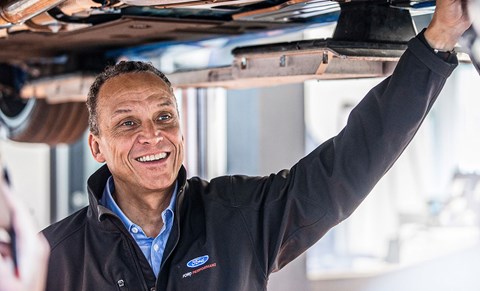
Complexities include replacing the boot floor because the standard car’s spare wheel well was in the way, fitting an entirely new ‘saddle’ type fuel tank, and swapping the rear subframe for an item that one of Johnson’s engineers originallydesigned for Volvo 10 years ago (the Focus still being based on the ‘C1’ platform developed while Ford, Volvo and Mazda were bedfellows). Finding this ‘breathed’ too much when subject to RS-level forces, additional strengthening was added, which then effectively defeated the rear crash structures, leading to further head scratching. With more reinforcement within the bodyshell and on the front subframe, the RS is 23% stiffer than a regular Focus overall, but 200% stiffer in key areas. Other bespoke RS elements include lower balljoints and knuckles at the front, increasing camber to -1.5 degrees for extra grip, while the front power transfer unit and some of the bushes actually come from the Kuga. All of this has to be managed on a factory line already bursting to capacity. You get the idea.
And even once all-wheel drive was agreed, it’s not as if Johnson and his team went for the easy option. ‘We built a Haldex prototype,’ he explains, ‘and then said “we’re not doing that”.’ He’s not a fan of the system used by basically every rival – at his most succinct he describes it in four-letter form – largely because the advantages over front-wheel drive are rooted in straight-line traction alone. ‘For understeer, those all-wheel-drive systems do nothing,’ he claims. Ford’s system is intended to be rather more active, or as Gagstatter puts it: ‘Like a rear-wheel-drive car with an enormous amount of grip’. The distinction is instantly apparent from the passenger seat.
Can you genuinely tell how immediate the front end feels from the wrong side of the car, how resistant it is to washing wide through Lommel’s ‘Track Seven’ hairpins – the scene of so many offs? Not definitively. But what is unquestionable is just how straightforward it is for the technician driving to bring the back axle into play. Not in terms of lurid tailslides (that comes later, on a skid pan), but in the way he’s able to adjust the car’s corner-exit trajectory under power. Nosing down the road like a laser or neatly sidestepping the rear tyres for a flourish, the RS feels unerringly transparent in its intentions and almost shockingly keen to do the driver’s bidding. Yet he’s so relaxed behind the wheel and so clearly not trying overly hard – with this brief demonstration of its prowess, carefully controlled though it is, you can’t help thinking this Focus is going to make the Golf R and Audi RS3 seem as agile as an oven glove. Exactly how has Ford achieved this using essentially the same all-wheel-drive system as the Range Rover Evoque?
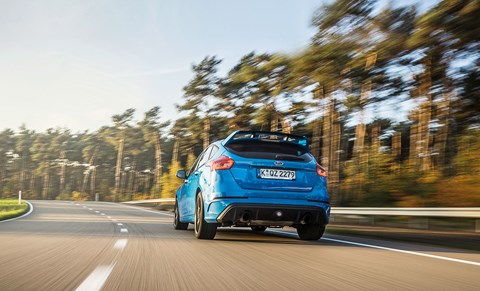
Let’s bust that myth. Pointing at the Rear Drive Unit (RDU) on the underside of an RS that’s been conveniently hoisted up in one of Lommel’s garages, Johnson explains. ‘Land Rover takes a unit like this from the same supplier, GKN. But our unit is different now. We actually used some of the Land Rover components early on in the programme, but we broke them all.’ Deadpan, but you can tell he’s grinning inside. ‘So we’ve changed it completely. The housing is different, the internals are different, the gears are different – basically everything’s different now. And we’ve made it more compact to fit our space.’
He’s not kidding about compact. Sitting at the junction between the three-piece propshaft and the two rear drive shafts is a silver box that looks barely bigger than a loaf of bread – certainly much smaller than a conventional differential. It houses a pair of electronically controlled clutches, one for either side of the car, constantly varying the amount of drive going to each rear wheel and enabling the RS to achieve true torque vectoring. A Haldex system can only control the distribution front and rear; in the Focus up to 100% of available rear torque – and that’s nominally 70% of the total at most, though Ford has seen up to 95% real world delivery in testing – can be sent to a single rear wheel. It’s not hard to see the dynamic potential, while outright traction and launch control means 0-62mph in 4.7sec.
‘The brains of it all is the software,’ Johnson stresses, before acknowledging the initial size of the gulf between the potential and the actual. ‘When we first started out on this we thought: once we get the RDU, everything else will be a piece of cake. Well, once we got it, that’s when the work started. Because itdidn’t exactly work the way we wanted it to work. Or the way that we expected it was going to work.’ This led to an epic amount of calibration effort, managing input from ‘literally dozens of sensors’ and complicated by the decision to offer four distinct – really distinct – driving modes: Normal, Sport, Track and Drift. Tuning each of these required a huge amount of graft. ‘And then figuring out the right combination…’ Johnson practically shudders. ‘I mean endless, endless discussion on the right combination of the various factors that we had to try to decide about settings. We think we got it right.’
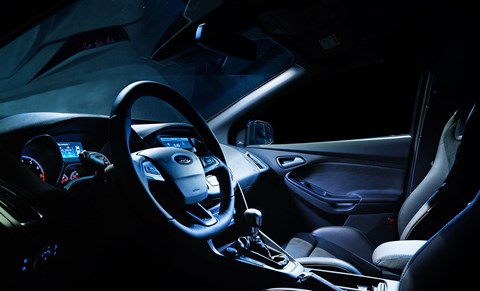
If this is all sounding a little too PlayStation for you, Gagstatter may offer some reassurance. Not only does he confirm the software work was done by the same team responsible for the near-omniscient ‘torque vectoring by brake’ that allows the Fiesta ST to dance a jig around its front axle – we can’t think of better provenance, and the Focus RS has this as well – he explains that Ford retains a thoroughly hardware-driven approach. ‘You start with the basic hardware tuning. Forget about electronics, electronic systems, because our philosophy is you do not want electronics to mask hardware and set-up weaknesses.’
It also couldn’t be all hardcore, all the time, since, as Johnson puts it, ‘this generally is not going to be someone’s toy car. This is going to be their car that they take to the grocery store with the kids in the back.’ Hence additional complications/features such as the ‘dual-mode’ Tenecco dampers, which can be switched from Normal to Sport and vice versa in any of the drive modes via a button located on the end of the indicator stalk. Again, differentiating the Focus from rivals, this is not a constantly variable system, but two individual damper curves, achieved via separate pathways within each damper unit and activated by a simple solenoid valve. Johnson says he wouldn’t use Sport on the road – nor the Nürburgring – that’s how much firmer it is. A section of Belgian pavé at Lommel confirms the contrast. Brutal. But on a smooth racing circuit the extra body control should ensure faster lap times.
Amongst all of this multi-faceted capability, does it not still seem incongruous that a company like Ford is offering a Drift Mode – no matter how much recruiting the marketing power of Ken Block helps it appear down with the scene kids? Johnson initially seems to agree: ‘It can get you into a lot of trouble,’ he says, and he doesn’t just mean legally. This, however, is more a concern about people presuming an artless button press will turn them into a hero when its unmitigated abuse is quite capable of seeing the foolhardy exit stage left, in all likelihood pursued by a (smokey) bear. So why offer it at all?
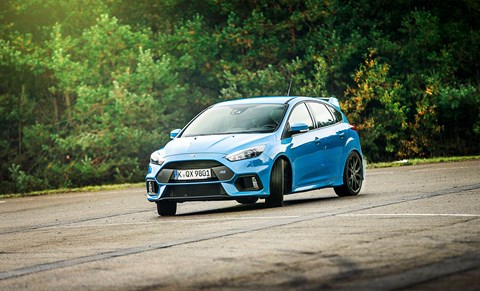
‘Number one,’ says Gagstatter, ‘obviously it demonstrates what you can do with this kind of all-wheel-drive system, that you cannot do with other types of all-wheel drive system. Number two, this is a car which is also aimed to appeal to the driver enthusiast.’ Unsurprisingly, it works by manipulating the torque distribution at the rear axle to encourage the back end to step out, and both he and Johnson are at pains to underline that, as with every other driving mode, the intention is a consistency and transparency in response that leads to a controlled, intuitive experience. ‘Even if you are not a professional driver you will quickly be relatively fast,’ Gagstatter insists. He also confirms that by default Drift Mode keeps the electronic stability control switched on – ‘It’s in Sport mode, but it is still active. So the system still helps you if you overdo it.’ Turn the ESC all the way off, though – which the RS will allow – and ‘you are on your own.’
On the skid pan, the car emphasises this by vaporising its rear tyres and performing donuts so tight it’s practically rotating within its own length. Our driver humbly describes himself as the ‘average Joe’ on the development team.
What a prospect: a five-door family car that’s aiming to allow anyone with halfway competent car control to out-drift a new BMW M2 while retaining enough duality to fulfil the purpose inherent in its fundamental description. It’s like a Mk1 Escort and an Escort RS Cosworth had a little bit more than a drunken fumble at the Christmas party, and we’re all eagerly awaiting a result that’s either going to be hugely embarrassing or one of the best decisions Ford has ever made. We’ll know once we’ve driven it in January.
The breakdown
Front bumper: Biggest possible aperture aids cooling, while spoiler targets ‘zero lift’ aerodynamic goal. ‘This is not easy to do on a road car,’ says Johnson
Brakes: Ducts and ‘jet tunnels’ direct cooling air to the 350mm front Brembos, ‘the biggest ever fitted to an RS’. Calipers have four 38mm pistons. Optimising brake cooling saw 20% improvement: ‘We stopped the car from 137mph 13 times in a row before seeing any fade’
Engine: Johnson: ‘We went to the Mustang guys originally and said we’ve got an idea to make your engine more powerful. They weren’t interested. Now they are’
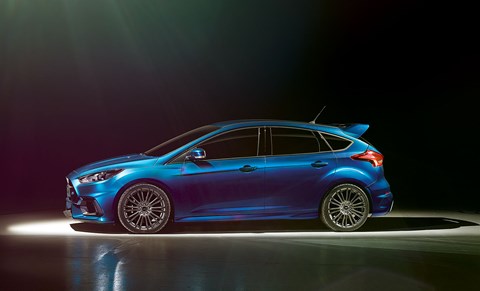
Suspension: Dual-mode dampers are 40% stiffer in Sport setting, intended for circuit use only. ‘Don’t complain to me if it’s too much on the road!’ says Johnson. Front springs are 33% stiffer, rears 38%. The rear subframe was originally designed for Volvo. Ford had to check it wouldn’t contravene rear crash regs
Wheels: 19-inch alloys with Michelin Pilot Super Sport tyres as standard; forged option saves 950g per wheel and is available with Michelin Pilot Sport Cup 2 tyres
Steering: 2.5 turns lock-to-lock, linear ratio, electrically assisted with Normal and Sport weightings. Johnson: ‘We spent a lot of time on steering tuning’
Transmission: A twin-clutch auto would shave three-tenths from the 0-62mph time, Johnson reckons. But it would also cost more, weigh more (28kg), and be less fun
Performance: Johnson claims none of the performance targets have changed since 2012 – and the RS achieved all of them. Eventually. ‘It’s not about the times, it’s about the experience of driving this car.’ Still: 0-62mph in 4.7sec and 165mph flat out – in a Focus?
Exhaust: It is basically straight-through to the rear silencer – ‘It passes drive-by noise regulations. Just.’ An ‘injection strategy’ adds extra snap, crackle and pop
The spec: Ford Focus RS
Price: £28,940
Engine: 2261cc turbo 4-cyl, 345bhp @ 6000rpm, 324lb ft @ 2000-4500rpm (347 on overboost)
Transmission: 6-spd manual, awd
Suspension: MacPherson strut with semi-isolated subframe front; SLA independent with control blade rear
Performance: 4.7sec 0-62mph, 165mph, 36.7mpg, 175g/km CO2
Length/width/height: 4390/1823/1472mm
Weight/made from: 1599kg/steel
On Sale: Now, first deliveries spring 2016